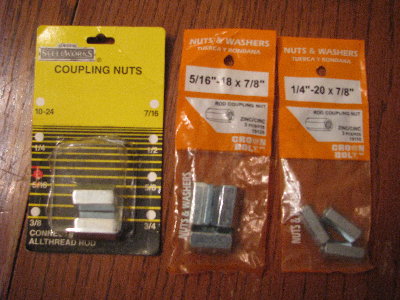Rack 56,
I have upgraded my hardware with threaded rod coupling nuts (or also called rod coupling nuts) to replace regular narrow stock nuts on the tuning hooks. These come as Zinc plated steel hardware that can be purchased at hardware stores. I have purchased these this past week for less than $2 for a bag of 3 at Home Depot and around $2.50 for 2 at Menards. The quality varies for these parts and the supply is sometimes rather limited due to lack of great demand and construction is down.

- Super nuts substitute
I have found that some of these need to be cleaned up by running a tap through the coupling nut to clean out any burs or imperfections. Also I have used a die to cleanup old threaded hardware of damage to the threads. I have found that some hardware is 5/16"-18 and others are 5/16"-24 (the second number is the # of threads per inch). I can only find 5/16"-18 rod couplings so I will try to re-thread these to 5/16"-24. I will let you know soon if I am successful or ruin the rod coupling nut.
When using a tap or die, you need to firmly secure your hardware that is being worked on and use oil to lubricate the cutting tap or die. Also if you get stuck, easily back off the tap or die oil and either back it out altogether and clean the cutting edge or simply backing it off and re-cutting will work. DO NOT FORCE A TAP OR DIE AND USE OIL OR YOU WILL BREAK THE TAP OR DIE INSIDE OR AROUND YOUR HARDWARE!
I hope this helps.
Keep it fun!
Jerry
